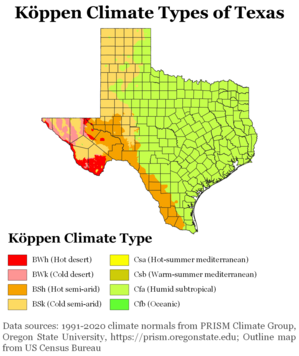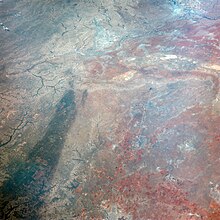

Texas' weather varies widely, from arid in the west to humid in the east. The huge expanse of Texas encompasses several regions with distinctly different climates: Northern Plains, Trans-Pecos Region, Texas Hill Country, Piney Woods, and South Texas. Generally speaking, the eastern half of the state is humid subtropical, while the western half is largely semi-arid (except arid in the far west).
Texas ranks first in tornado occurrence with an average of 139 per year. Tropical cyclones can affect the state, either from the Gulf of Mexico or from an overland trajectory originating in the eastern Pacific Ocean. Those originating from the Gulf of Mexico are more likely to strike the upper Texas coast than elsewhere. Significant floods have occurred across the state throughout history, both from tropical cyclones and from stalled weather fronts.